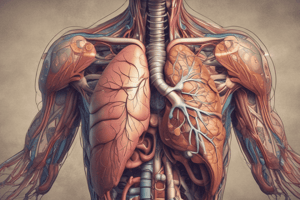Podcast
Questions and Answers
What are the general building plan components of a respiratory airway?
What are the general building plan components of a respiratory airway?
Epithelial tissue, Connective tissue, Muscle tissue, Nerve tissue
List the basic components of the conducting and respiratory portions of the respiratory system.
List the basic components of the conducting and respiratory portions of the respiratory system.
Nasal cavity, Pharynx, Larynx, Trachea, Bronchi, Bronchioles, Respiratory bronchioles, Alveolar ducts, Alveoli
Identify the structure that includes the trachea, bronchi, terminal bronchioles, and alveoli based on epithelial cell types and other features.
Identify the structure that includes the trachea, bronchi, terminal bronchioles, and alveoli based on epithelial cell types and other features.
- Intrapulmonary airways (correct)
- Conducting airways
- Extrapulmonary airways (correct)
- Respiratory airways
What cellular and structural elements form the blood-air barrier?
What cellular and structural elements form the blood-air barrier?
What histological differences exist between an active and inactive breast?
What histological differences exist between an active and inactive breast?
Which of the following are part of the functional groups of the respiratory tracts?
Which of the following are part of the functional groups of the respiratory tracts?
The __________ airway includes the nasal cavity, pharynx, and larynx.
The __________ airway includes the nasal cavity, pharynx, and larynx.
The __________ airway includes the respiratory bronchiole and alveolar ducts.
The __________ airway includes the respiratory bronchiole and alveolar ducts.
Study Notes
Primary Tissues in Respiratory System
- Tissues are composed of cells and extracellular matrix (ECM).
- Four primary types of tissues: epithelial, connective, muscle, and nerve.
Respiratory Airway Functions and Structure
- Study focuses on the bronchus as a model for general airway structure.
- Airways are divided into two structural groups: extrapulmonary and intrapulmonary.
- Extrapulmonary includes nasal cavity, pharynx, larynx, trachea, and bronchi.
- Intrapulmonary includes tertiary bronchi, bronchioles, respiratory bronchioles, alveolar ducts, and alveoli.
Conducting and Respiratory Portions
- Conducting airways: nasal cavity, upper airways, trachea, bronchi.
- Respiratory airways: respiratory bronchioles, alveolar ducts, and alveolar sacs.
- Each component features unique structural attributes that support specific respiratory functions.
Blood-Air Barrier
- The blood-air barrier is formed by cellular and structural elements that facilitate gas exchange.
- This barrier consists of alveolar epithelial cells, capillary endothelial cells, and the underlying basement membrane.
Histological Differences
- Active and inactive breast tissues exhibit distinct histological characteristics.
- Study involves identifying and annotating differences in cellular structure and arrangements.
Visual Aids
- Annotate sketches and photomicrographs to support understanding of bone histology.
Structural Components to Identify
- Trachea
- Bronchi
- Terminal bronchioles
- Respiratory bronchioles
- Alveolar ducts
- Alveoli
Basic Building Plan of Airways
- Airways structure includes a variety of epithelial cell types, glands, cartilage, smooth muscle, and connective tissue fibers.
- Understanding the distribution of these components is crucial for identifying respiratory tract structures.
Key Facts
- The respiratory system has distinct functional groups (conducting vs. respiratory).
- Knowledge of histology is essential for understanding respiratory function and pathology.
Studying That Suits You
Use AI to generate personalized quizzes and flashcards to suit your learning preferences.
Related Documents
Description
This quiz covers essential aspects of the primary tissues found in the respiratory system, including epithelial, connective, muscle, and nerve tissues. It also delves into the structure and function of conducting and respiratory airways, the blood-air barrier, and the distinctions between extrapulmonary and intrapulmonary airways. Ideal for students studying respiratory anatomy and physiology.





